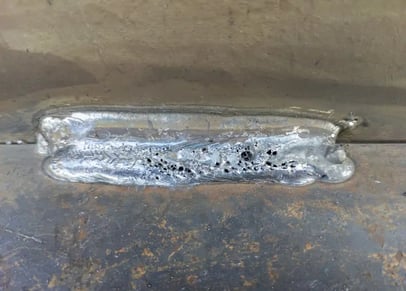Understanding What is Porosity in Welding: Reasons and Solutions
Understanding What is Porosity in Welding: Reasons and Solutions
Blog Article
Understanding Porosity in Welding: Checking Out Causes, Impacts, and Prevention Techniques
As specialists in the welding industry are well conscious, understanding the causes, results, and avoidance techniques associated to porosity is crucial for accomplishing durable and trusted welds. By diving into the origin causes of porosity, analyzing its detrimental results on weld top quality, and discovering effective avoidance strategies, welders can improve their knowledge and abilities to create high-quality welds constantly.
Usual Sources Of Porosity
Contamination, in the type of dirt, grease, or rust on the welding surface area, creates gas pockets when heated, leading to porosity in the weld. Inappropriate shielding occurs when the securing gas, commonly made use of in procedures like MIG and TIG welding, is unable to completely protect the molten weld swimming pool from reacting with the surrounding air, resulting in gas entrapment and succeeding porosity. Additionally, insufficient gas coverage, usually due to incorrect flow prices or nozzle positioning, can leave components of the weld unguarded, allowing porosity to form.
Impacts on Weld Top Quality
The existence of porosity in a weld can substantially jeopardize the general high quality and stability of the welded joint. Porosity within a weld creates spaces or tooth cavities that compromise the structure, making it more at risk to fracturing, deterioration, and mechanical failure.
In addition, porosity can impede the effectiveness of non-destructive screening (NDT) techniques, making it challenging to detect other defects or discontinuities within the weld. This can bring about substantial safety problems, especially in vital applications where the architectural honesty of the welded elements is critical.

Prevention Techniques Overview
Provided the harmful effect of porosity on weld high quality, efficient avoidance methods are crucial to preserving the architectural stability of bonded joints. One of the main avoidance strategies is detailed cleaning of the base products prior to welding. Contaminants such as oil, grease, rust, and wetness can add to porosity, so ensuring a clean job surface area is vital. Correct storage of welding consumables in dry conditions is likewise crucial to stop dampness absorption, which can lead to gas entrapment during welding. Additionally, picking the appropriate welding specifications, such as voltage, existing, and take a trip speed, can aid minimize the danger of porosity development. Making certain adequate securing gas flow and coverage is one more vital avoidance technique, as inadequate gas insurance coverage can cause climatic contamination and porosity. Ultimately, correct welder training and certification are important for executing safety nets effectively and consistently. By including these avoidance methods right into welding techniques, the event of porosity can be considerably minimized, leading to more powerful and a lot more dependable welded joints.
Value of Proper Protecting
Appropriate protecting in welding plays a crucial function in preventing climatic contamination and ensuring the integrity of bonded joints. Shielding gases, such as argon, helium, or a blend of both, are commonly utilized to secure the weld pool from reacting with components in the air like oxygen and nitrogen. When these reactive elements enter into contact with the warm weld pool, they can cause porosity, bring about weak welds with lowered mechanical buildings.

Inadequate shielding can cause numerous issues like porosity, spatter, and oxidation, endangering the architectural stability of the welded joint. For that reason, adhering to proper pop over to this web-site securing methods is necessary to create premium welds with very little defects and ensure the long life and dependability of the welded components (What is Porosity).
Surveillance and Control Techniques
How can welders properly keep an eye on and control the welding procedure to ensure optimum results and prevent flaws like porosity? One key approach is through the usage of advanced tracking technologies. These can consist of real-time monitoring systems that offer responses on parameters such as voltage, current, travel rate, and gas circulation rates. By continually keeping track of these variables, welders can recognize discrepancies from the excellent conditions and make instant changes to avoid porosity development.

Furthermore, carrying out appropriate training programs for welders is necessary for keeping an eye on and managing the welding process properly. What is Porosity. Enlightening welders on the importance of maintaining recommended you read consistent parameters, such as appropriate gas protecting and travel speed, can help avoid porosity issues. Regular assessments and qualifications can additionally make certain that welders are competent in monitoring and managing welding processes
Additionally, using automated welding systems can enhance monitoring and control capacities. These systems can specifically control welding specifications, decreasing the likelihood of human mistake and making certain constant weld quality. By combining innovative tracking technologies, training programs, and automated systems, welders can successfully keep track of and control the welding process to reduce porosity defects and attain high-grade welds.
Final Thought

Report this page